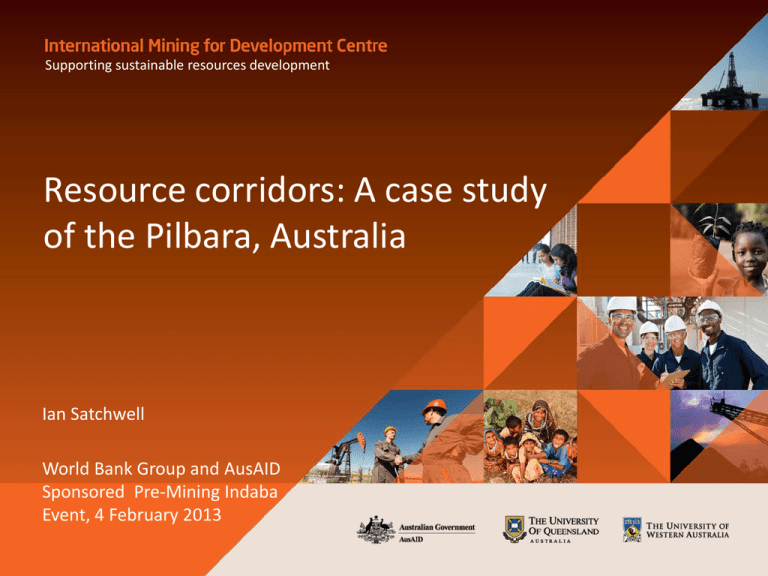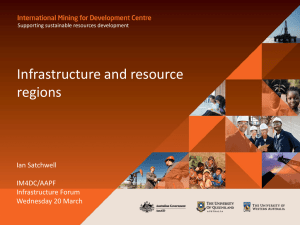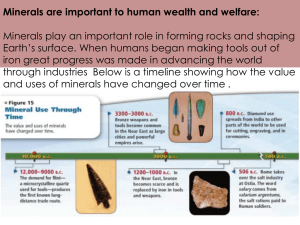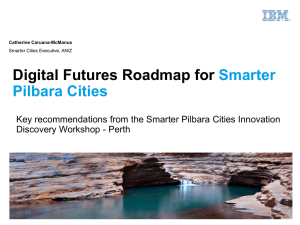Resources Corridors – Presented to the Harnessing Africa`s Mineral
advertisement

Supporting sustainable resources development Resource corridors: A case study of the Pilbara, Australia Ian Satchwell World Bank Group and AusAID Sponsored Pre-Mining Indaba Event, 4 February 2013 Outline • Market and development overview • Overview of the Pilbara • Phases of Pilbara development • Key infrastructure issues though the phases • Current planning approaches • Some lessons learned 2 The Pilbara Region is well located to supply Asia with minerals and energy products 3 Australia’s engineering and construction challenge – the largest investment wave since the 1800s gold rushes* WA & NT projects to 2016: USD220 billion+ LNG, mining DARWIN Offshore petroleum basins Pilbara Region: LNG, iron ore, infrastructure Queensland projects to 2016: USD100 billion+ Base metals BROOME PORT HEDLAND KARRATHA Queensland Western Australia Mid West Region Iron ore, gold, uranium, nickel, South Australia BRISBANE Copper, uranium New South Wales PERTH South West Region Alumina, gold *Reserve Bank, Australia Bowen Basin: Coal, CSG, LNG, infrastructure Northern Territory SYDNEY ADELAIDE CANBERRA Victoria South Australia projects to 2016 USD30 billion+ MELBOURNE HOBART 4 Pilbara orientation 5 Strong growth of minerals and energy output from Pilbara At present, around 55 per cent of worldwide LNG capacity under construction is located in Australia. By 2015-16, Australia’s LNG exports are forecast to increase to 41 million tonnes, an increase of 126 per cent from 2010-11. Growth in Australian LNG production located in the Pilbara Region In 2015-16, iron ore export earnings are projected to reach $68 billion (in 2010-11 dollars), as strong growth in export volumes offsets lower prices. Growth in iron ore exports from the Pilbara Region 1500 1250 1000 6 Pilbara Region dominates Western Australia’s Gross State Product Value of minerals and energy production from Pilbara (2011) Minerals Iron Ore Gold and Silver Copper Manganese and Salt Construction Materials Tantalite, Tin and Gems Total Offshore Petroleum Crude Oil and Condensate Liquefied Natural Gas Natural Gas LPG Butane and Propane Total Other industry sectors Manufacturing Agriculture Retail Value $Millions 60,299 1,006 643 585 72 60 62,665 12,004 9,344 1,401 746 23,495 Value $Millions 350 50 400 Goldfields-Esperance 8% Wheatbelt 2% Mid West 2% Peel 5% Commonw ealth Offshore Petroleum (mostly Pilbara) 21.5% Other 2% Pilbara 59% State Offshore Petroleum 0.5% The Pilbara generates ~ 80% of WA’s minerals and energy production value of $107 billion (2011) The Pilbara has a Gross Regional Product larger than some Australian states, but most flows elsewhere – including to Perth and as returns to capital. 7 Phases in development of Pilbara Region 1960s 1970s 1980s Founded on iron ore Iron ore deposits delineated; First mines, railways, ports and towns established under State Agreements and funded by major mining companies; Population <10,000 Further mines and mine towns established; Project-specific State Agreements written for iron ore, solar salt; Offshore petroleum deposits delineated; Govt. plans for diversified industry in Pilbara 1990s Energy emerges Growth of iron ore production based on Japanese demand; North West Shelf Venture Domgas & LNG projects commissioned; Manganese and gold mining started New mines established by all three major companies; Growth of iron ore production and expansion of NWSV LNG project based on Japanese demand; BHP builds HBI plant; Govt. plans estate for petrochemical industry; Native Title Act passed 2000 2010 2020 Chinese demand Rio Tinto acquires Robe; BHPB merges with Billiton these majors increase iron ore production; BHP HBI plant closes; Expansion of NWSV LNG project; Pluto LNG project; Gorgon JV State Agreement for Barrow Island; Pilbara Cities policy Growth of iron ore production based on Chinese demand; Entry of new iron ore producers; Gorgon LNG construction begins; Fly in / Fly Out workforces; Population 45,000 Wheatstone LNG project construction; Onslow to be a new LNG industry hub; Looking into the future: Iron ore 600 Mtpa (+150% on 2010); LNG 50 Mtpa (+200% on 2010); Population 60,000? 8 Pilbara infrastructure investment Founded on iron ore • Early development 1960s – 1980 ● Three iron ore producers, two salt operations – steady growth, short term planning, based on Japanese demand – all developments under State Agreements on project-by-project basis ● Companies provided most infrastructure – rail, ports, water, power, housing, community infrastructure – infrastructure responsibilities defined by State Agreements – production infrastructure (rail, ports, power, water) planned, funded and built by companies, subject to government approval under Agreements – rail and ports seen as part of production chains - used only by owner – government provided roads, power distribution and water distribution, and education and health services ● Focus of governments was on commitments by companies under Agreements to future ‘value added’ processing 9 Pilbara infrastructure investment Energy emerges • New opportunities for development 1980s – 2000 ● Offshore natural gas emerges as game-changer in WA economy – State funds Dampier – Perth natural gas 1500 Km pipeline – State energy agency signs take-or-pay for domestic gas to underwrite NWS – all developments under project-by-project State Agreements ● ● ● ● ● ● LNG exports by NWS JV commence and grow three fold New, major gas fields discovered offshore from WA Government plans estate for petrochemicals and other gas processing BHP builds and closes iron ore processing (HBI) plant in $3 billion failure Fly-in / fly-out used to minimise community infrastructure costs Commonwealth passes Native Title Act 10 Pilbara infrastructure investment Chinese demand • Development since 2000 ● Multiple iron ore companies (including Chinese FDI), four LNG developments/operations, several other mining operations – rapid growth, multiple options, long term planning ● Companies still provide production infrastructure – rail, ports, water, power, employee housing – production infrastructure (rail, ports, power, water) used mostly by owner – rail and ports part of production chains ● ● ● Sharing of now-State-owned ports, litigation over sharing of rail ‘Normalisation’ of towns – several now support multiple company operations Governments provide community infrastructure and develop towns – shortage of housing and community facilities and services (eg, education and health); high housing construction and rental costs 11 Future Pilbara production represents a quantum shift in output Iron ore Source: Draft Pilbara Planning and Infrastructure Framework 2011 Oil and gas (LNG) 12 Infrastructure planning changes ● Overall – cooperative planning within agreed growth parameters – hypothecation of royalty revenues to fund infrastructure ● Ports – move to multi-user ports to allow for investment diversity ● Rail – future multi-user railways with independent operator 13 Pilbara Planning and Infrastructure Framework – consolidation of towns 14 Transport infrastructure – integrated planning; prospect of a multi-user rail line 15 Infrastructure planning changes (2) ● Roads – long-term planning, increased government investment, ● Land, housing and community infrastructure – long-term planning; coordination between companies and government ● Energy – government seeking to establish Pilbara electricity grid ● Water – cooperation between companies and government 16 Utility infrastructure – moving to integrated electricity system 17 Differences in Pilbara population projections – Pilbara Industry Community Council (2010) and WA Planning Commission (2011) WAPC assumes further mining investment and economic transformation beyond 2015 PICC assumes construction will tail off from 2015 18 Karratha growth plan – ensuring infrastructure for service industry 19 What we have learned • Predicting the future is very difficult ● a guiding overall vision is needed, with agility to respond to global forces ● uncertainty (in part) can be managed though options • Early planning and coordination of infrastructure is essential ● infrastructure development must be timely to match output growth ● infrastructure investment inextricably linked to commodity market risks ● managing risks and rewards essential for government and industry infrastructure ● coordination is essential to minimise costs and to maximise utility and efficiency ● partnerships between government – mining industry – infrastructure providers needed, but government needs to be careful about getting financially involved in mining busines • Efficient integrated production chains are vital for global competitiveness of resource development operations • Resource corridors provide holistic approach and options for future development 20 Contact International Mining for Development Centre The University of Western Australia M460A, 35 Stirling Highway Crawley WA Australia 6009 Tel: +61 8 6488 2489 Email: admin@im4dc.org www.im4dc.org The Energy and Minerals Institute The University of Western Australia M460A, 35 Stirling Highway Crawley WA Australia 6009 Tel: +61 8 6488 4608 Email: emi@uwa.edu.au Web: www.emi.uwa.edu.au The Sustainable Minerals Institute The University of Queensland St Lucia Brisbane QLD Australia 4072 Tel: +61 7 3346 4003 Email: reception@smi.uq.edu.au Web: www.smi.uq.edu.au








